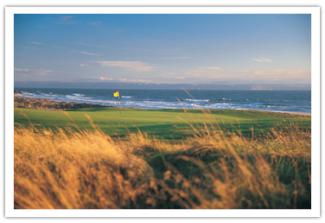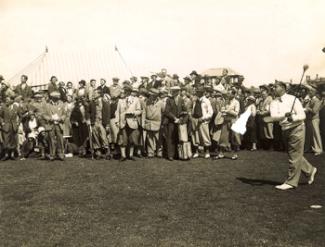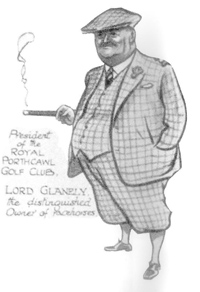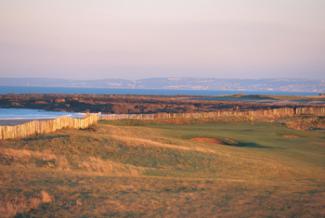Featured Golf News
The Story behind Royal Porthcawl
Porthcawl is situated 30 miles west of Cardiff and 22 miles east of Swansea. It is set on the South Wales coast overlooking the Bristol Channel and, with a number of beaches around the town, has evolved into a seaside town since the Victorian era and remains one of Wales' most enduring holiday resorts.

1st Hole at Royal Porthcawl
Beginnings
Royal Porthcawl is undoubtedly the most prestigious golf club in Wales. It originated when a group of Cardiff businessmen met to form a golf club in 1891. Many of the founders were involved in the export of coal and in other shipping activities. This period was extremely fruitful, as many made fortunes over the preceding decades. The coal from the valleys was plentiful and in much in and many coal and rail entrepreneurs and owners acquired a great deal of wealth.
Between 1851 and 1901, Cardiff increased its population sevenfold and the city was the place where many of the wealthy merchants of South Wales and southern England eventually settled. During this period where workers had their rugby clubs, the business owners were looking to build a place for their sport. Thus, the Golf Club at Porthcawl was set up by a number of businessmen and built on traditional Victorian values, espousing "positive, moralistic and upstanding."
On November 13, 1891, the first meeting took place to decide the club rules and a place for a golf course. As many of the founder members made their living through exporting coal from Cardiff and Barry Docks, they were familiar with the coastlines around these towns. Not surprisingly, they settled on Porthcawl, an 18th-century coal-exporting center and a place that was just beginning to become a popular tourist destination.
Early lists of members read like a "Who's Who" of the rich from Cardiff and the Vale of Glamorgan. On the members' register at 1895 are many ministers, solicitors, army and navy officers, doctors, professors, and even Lord Tredegar of Tredegar Park, Newport. The club still seems aware of what a special position it has, and the place has developed an atmosphere of exclusivity that goes with the knowledge that Royal Porthcawl is the best.
The staff is polite, courteous and a little deferential. There is a sense of awe when you enter the changing rooms, almost like that of walking backwards into a Victorian Era, with a feeling of "class" permeating the place. It seems to be something that goes with the club, its members and buildings. The rest home next to the clubhouse is where the famous nurse Florence Nightingale worked; the walls in the bars and changing rooms are filled with photographs of famous members and visitors.
As John Hopkins wrote in "Golf Wales" (Graffeg, 2007) of Royal Porthcawl's members: "For well over one century they have hung their jackets on hooks that look as though they are over one-hundred years old, sat on benches that have served thousands of golfers down the years and noted the memorabilia that surrounds them - the photographs of the club captains for example, the portrait of Edward VIII, the Prince of Wales, who would become a patron of the club."
This sense sets Royal Porthcawl apart from most other Welsh clubs, but it may be a problem in the future. As golf becomes a more and more democratic and populist game, will Royal Porthcawl be able to survive charging over £100 a round and recruiting new members by invitation-only? I suspect the answer will be "Yes." Modern business theory would say that although 99% of businesses survive by being "fit," lean, dynamic and flexible, there is still the 1% - Ferrari, Harley-Davidson, BMW, Gibson Les Paul, St. Andrews and Royal Porthcawl - that survive by being "sexy," unique, timeless and prestigious.

1995 U.S. Walker Cup Team at Royal Porthcawl
The fact that the club hasn't got the necessary infrastructure, transport systems, space, hospitality accommodation and other facilities to hold major tournaments seems a double-edged sword. No doubt, some are pleased the Royal Porthcawl can resist the change. Others, however, feel differently.
Leo McMahon, writing in "Royal Porthcawl 1891-1991," sums it up:
Regrettably shamefully, short-sightedly or mercifully, depending on one's viewpoint, Royal Porthcawl has not had these ingredients (the infrastructure) in measure enough to attract much in the way of professional golf in recent years, while in years gone by there was probably little fire in Members' bellies to pay much heed to professional golf."
Nonetheless, it's rated the top course in Wales and has a place in the prestigious "Top 100 Golf Courses in the World." Royal Porthcawl has hosted many leading amateur and professional tournaments, including the Walker Cup, the Amateur Championship (six times) Curtis Cup, European Team Championship, the Home Internationals (eight times), the Ladies British Open Amateur, Dunlop Masters, the Penfold and the Coral Classic. It's the course where Tiger Woods lost his singles in the 1995 Walker Cup to Gary Wolstenholme and the USA team fell 14-10 to Great Britain and Ireland.

Walter Hagen Teeing off at Royal Porthcawl
"Royal" Porthcawl
"The Lord Mayor of Cardiff received the invitation that it was the intention of His Majesty to confer the title 'Royal' on the Porthcawl Golf Club. This is the result of efforts which have been made for months past by Mr. Wyndham Jenkins, captain of the Club, to secure Royal recognition of the institution." South Wales Daily News, 1 April 1909
How the "Royal" came about remains a mystery. The documentation that exists shows that the club had petitioned for the designation before, but the reply from the Home Secretary of the time, Herbert Gladstone, indicated that this was not likely to happen: "Having regard to the precedents which govern such grants, after careful consideration I am unable to advise His Majesty to grant the desired privilege."
However, just six months later a letter arrived, again from Gladstone, this time informing the club that "After enquiry and consideration I have felt able to recommend the King to permit the Club to use the title 'Royal' and that His Majesty has been pleased to approve the recommendation."
Culture
In the excellent centenary book, "Royal Porthcawl 1891-1991," there are a number of excerpts that give a flavor of the club and the attitude of the members:
"Over the years it was decided to allow men into the Ladies' room after 6.00 p.m. and on weekend afternoons. However, this is not encouraged and very few gentlemen visit.
"In 1969 it was decided trouser suits would not be worn in the clubhouse as they might be offensive to the men.
"During the First World War all commanding officers and the officers of the Regiments stationed in the area were made honorary members. This was stopped in 1919.
"In 1943 American troops were stationed in Porthcawl and their officers were made honorary members."

Royal Porthcawl's Lord Glanely
Character
One of the early club presidents was William James Tatem (1915-1942), who later became Lord Glanely. He was born in Appledore, North Devon, and became one of the richest men of the day having founded the Tatem Steam Navigation Company. He became a director of most of the shipping companies operating from Bute Docks, Cardiff, which further increased his wealth. He was a racehorse owner, chairman of University College Cardiff, High Sheriff of Glamorgan, and by all accounts a buccaneering figure. How he gained his peerage has become the stuff of legends. He allegedly handed over a check for £50,000 to the political organizer working for David Lloyd George. The organizer asked Mr. Tatem why the check was signed "Glanely." Tatem replied; "Because my name is going to be Lord Glanely, and if it isn't, you won't be able to cash that check." He became Baron in 1916 and, in 1918, gained a peerage as the 1st Baron Glanely of St. Fagans.
In 1919, Tatem had two horses entered in the Derby. His favorite steed - which he told everyone - and the race favorite, was Dominion. His other horse, Grand Parade, who he secretly bet on, romped home at 33-1 odds. His horses also won every other classic, including 1,000 Guineas, 2,000 Guineas, Oaks and St. Leger.
Lord Glanely died in a bombing raid on Weston-super-Mare, Somerset in 1942.

The Approach to the 2nd Hole at Royal Porthcawl
(the above photos are courtesy of Royal Porthcawl)
The Course
Porthcawl is a typically demanding, seaside-links course. It was originally designed by Charles Gibson and later renovated by Tom Simpson. A feature of the course is that the sea is visible from every hole. The views are magnificent.
The course is designed to test golfers as the holes continually change direction to play against, with and across the wind, and it is frequently very windy here. The layout offers no protection from the wind in the form of trees or high dunes. The magnificent greens are fast and difficult. As McMahon describes the speed of the greens: "Putting into bunkers is quite commonplace, and one renowned lady golfer of yesteryear is alleged to have lost her ball putting downhill and downwind on the fifth green."
From the back tees the par-72 course measures 6,740 yards. For many Welsh club-playing amateurs, it is their "Augusta National," the place to play before they die. There is an aura about the club, and it is special.
As Michael Williams wrote in the Daily Telegraph: "Royal Porthcawl epitomizes all that is best about the game, as it once was, even down to a creaking clubhouse that is as unchanging as the magnificent links and unrivaled hospitality."
Byron Kalies is a native of Wales who has been writing professionally for six years. He recently completed his travels around Wales while researching the book, "From Tenby to Celtic Manor: a Cultural History of Golf in Wales." The book, published by Carreg Gwalch Books, will be available in spring 2010.
Byron has also published two management and training books, including "25 Management Techniques in 90 Minutes" (MB2000, 2005) and "A Trainer's Diary" (HRD Press, 2008). Byron has written articles and columns for a number of national and international publications, including: Advant Edge (U.S.), Business Day (South Africa), Career Times (Hong Kong), C.I.O. (U.K.), The Guardian (U.K.), Golf Today (U.S.), Management First (U.K.), Management Today (Australia), Marketing Magazine (N.Z.), Public Servant (U.K.), The Age (Australia) and The Scotsman.
Byron can be reached at: Byron Kalies, 3 St. David's Close, Libanus Fields, Pontllanfraith, Blackwood, South Wales, NP12 2FE. Telephone: +44 (0) 1495 222516l; email: byron@byronkalies.com; Website: www.byronkalies.com; Twitter: www.twitter.com/byronlk.
Story Options
 |
Print this Story |
